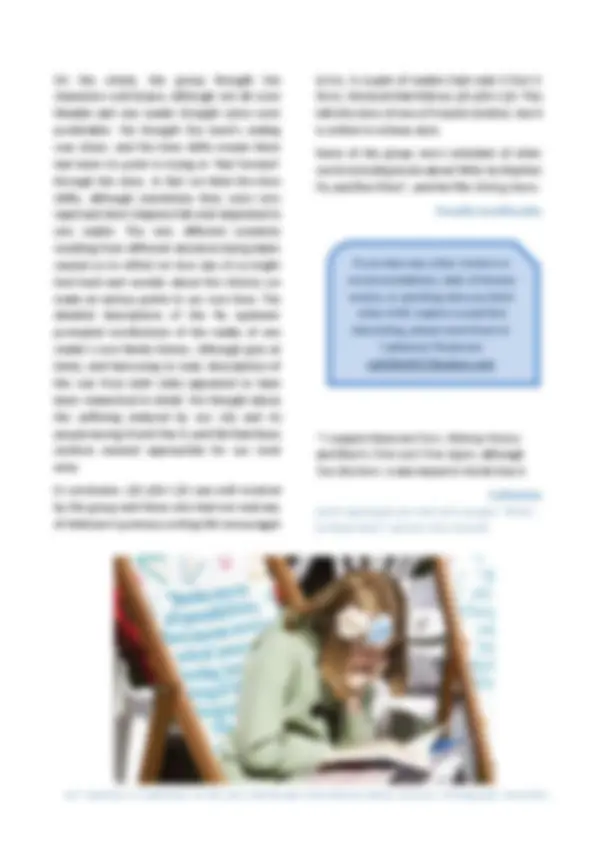



Study with the several resources on Docsity

Earn points by helping other students or get them with a premium plan


Prepare for your exams
Study with the several resources on Docsity

Earn points to download
Earn points by helping other students or get them with a premium plan
Community
Ask the community for help and clear up your study doubts
Discover the best universities in your country according to Docsity users
Free resources
Download our free guides on studying techniques, anxiety management strategies, and thesis advice from Docsity tutors
The june 2016 meeting of the avid readers group at earlsdon library, where they discussed the book 'life after life' by kate atkinson. An overview of the book's plot, the group's reactions, and their thoughts on the characters and time shifts. It also mentions the upcoming book for discussion in july, 'alice and the fly' by james rice.
Typology: Study Guides, Projects, Research
1 / 2

This page cannot be seen from the preview
Don't miss anything!


An Unfinished History
Life after Life by Kate Atkinson is an unusual book and, perhaps fittingly, the meeting began in a way that seems to have become a little unusual in recent months – the atmosphere was buzzing with positivity!
The book itself centres on the story of Ursula Todd, a child born in England in affluent and comparatively happy circumstances on 11 February 1910. However, every time the reader becomes engrossed in the story it simply stops. Then the narrative starts again – and again, and again – but from different starting points. Each time the story takes a different course, its details altered – sometimes radically, sometimes marginally – its outcome unpredictable.
From the moment of her birth onwards, Ursula’s childhood is punctuated by alarming near misses. Each disaster is confirmed by variations on the phrase ‘darkness fell’, and each new beginning heralded by the clean slate that snow brings. Ursula carries within her a vague sense of experiencing something ‘other’, which is expressed through apparently
impetuous actions – such as when she pushes a housemaid down the stairs to save her from a more terrible ending. Although the book is not by any means all bleak and unhappy, Atkinson’s descriptions of the traumatic shifts in British society during Ursula’s lifetime are convincing – the story moves directly from one war to the next, only later filling in, partially, the inter-war years. The vividly detailed passages of domestic and personal minutiae bring home some of the horrors and perils of wartime. Atkinson is a leading modern author who has been described as an exceptional writer – and Life after Life is said to be her most ambitious and most gripping work. This may be why most members of the group who had read the whole book, said they enjoyed it and used words such as ‘clever’ and ‘brilliant’ (even, ‘Well done on book choice’!!). Those who had not finished the book gave reasons such as leaving their copy behind on holiday, or being too busy, rather than not enjoying reading it, and most hoped to finish it in due course.
The newsletter of the AVID Readers Group, based at Earlsdon Library
On the whole, the group thought the characters well-drawn, although not all were likeable and one reader thought some were predictable. We thought the book’s ending was clever, and the time shifts meant there had been no point in trying to ‘fast forward’ through the story. In fact we liked the time shifts, although sometimes they were very rapid and short chapters felt a bit disjointed to one reader. The very different scenarios resulting from different decisions being taken caused us to reflect on how any of us might look back and wonder about the choices we made at various points in our own lives. The detailed descriptions of the flu epidemic prompted recollections of the reality of one reader’s own family history. Although gory at times, and harrowing to read, descriptions of the war from both sides appeared to have been researched in detail. We thought about the suffering endured by our city and its people during World War II, and felt that these sections seemed appropriate for our local area.
In conclusion, Life after Life was well received by the group and those who had not read any of Atkinson’s previous writing felt encouraged
to try. A couple of readers had read A God in Ruins, the book that follows Life after Life. This tells the story of one of Ursula’s brother, but it is written in a linear style. Some of the group were reminded of other works including books about Hitler by Stephen Fry and Ben Elton*, and the film Sliding Doors.
(with apologies for lack of a proper ‘What to Read Next’ section this month)
If you have any other reviews or recommendations, tales of literary events, or anything else you think other AVID readers would find interesting, please send them to: Catherine Fitzsimons cathfitz5317@yahoo.com
Girl reading in a deckchair at the 2011 Edinburgh International Books Festival. Photograph : Guardian